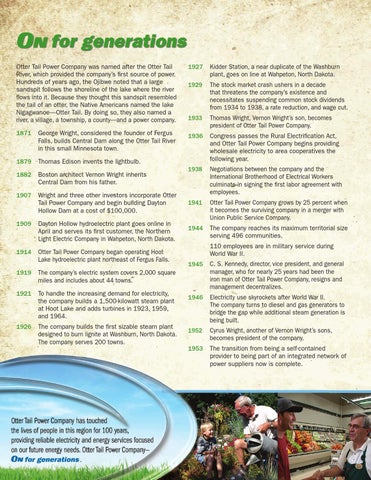Otter Tail Power Company was named after the Otter Tail River, which provided the company’s first source of power. Hundreds of years ago, the Ojibwe noted that a large sandspit follows the shoreline of the lake where the river flows into it. Because they thought this sandspit resembled the tail of an otter, the Native Americans named the lake Nigagwanoe—Otter Tail. By doing so, they also named a river, a village, a township, a county—and a power company.
1927
Kidder Station, a near duplicate of the Washburn plant, goes on line at Wahpeton, North Dakota.
1929
The stock market crash ushers in a decade that threatens the company’s existence and necessitates suspending common stock dividends from 1934 to 1938, a rate reduction, and wage cut.
1933
Thomas Wright, Vernon Wright’s son, becomes president of Otter Tail Power Company.
1871
George Wright, considered the founder of Fergus Falls, builds Central Dam along the Otter Tail River in this small Minnesota town.
1936
1879
Thomas Edison invents the lightbulb.
Congress passes the Rural Electrification Act, and Otter Tail Power Company begins providing wholesale electricity to area cooperatives the following year.
1882
Boston architect Vernon Wright inherits Central Dam from his father.
1938
1907
Wright and three other investors incorporate Otter Tail Power Company and begin building Dayton Hollow Dam at a cost of $100,000.
Negotiations between the company and the International Brotherhood of Electrical Workers culminate in signing the first labor agreement with employees.
1941
1909
Dayton Hollow hydroelectric plant goes online in April and serves its first customer, the Northern Light Electric Company in Wahpeton, North Dakota.
Otter Tail Power Company grows by 25 percent when it becomes the surviving company in a merger with Union Public Service Company.
1944
The company reaches its maximum territorial size serving 496 communities.
1914
Otter Tail Power Company began operating Hoot Lake hydroelectric plant northeast of Fergus Falls.
1919
The company’s electric system covers 2,000 square miles and includes about 44 towns.
1921
To handle the increasing demand for electricity, the company builds a 1,500-kilowatt steam plant at Hoot Lake and adds turbines in 1923, 1959, and 1964.
1926
The company builds the first sizable steam plant designed to burn lignite at Washburn, North Dakota. The company serves 200 towns.
110 employees are in military service during World War II. 1945
C. S. Kennedy, director, vice president, and general manager, who for nearly 25 years had been the iron man of Otter Tail Power Company, resigns and management decentralizes.
1946
Electricity use skyrockets after World War II. The company turns to diesel and gas generators to bridge the gap while additional steam generation is being built.
1952
Cyrus Wright, another of Vernon Wright’s sons, becomes president of the company.
1953
The transition from being a self-contained provider to being part of an integrated network of power suppliers now is complete.
